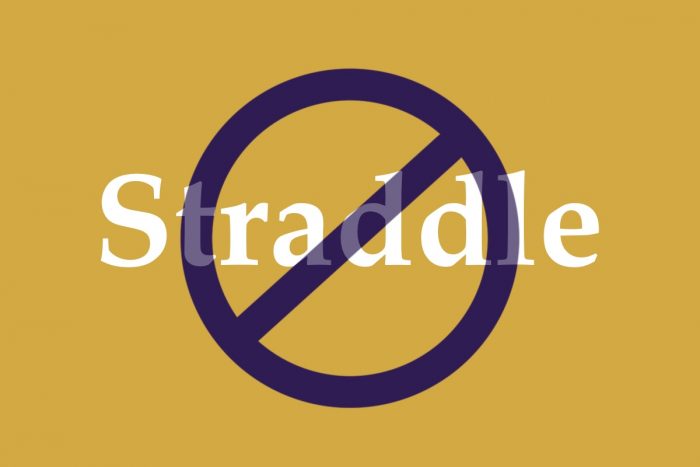Straddling in poker is something that most people have different opinions on. Some players may say it is good for the game and that it creates action. Others will tell you straddling is unnecessary and only eats at your win rate. Regardless of your stance on straddling, here are some pros and cons.

What is a Straddle in Poker?
Straddling is when you voluntarily put out a third blind before you get your cards. Unlike a blind raise, a straddle acts as the new big blind, so if all players limp to you, you have the option of checking or raising. There are a few different versions of straddling allowed depending on where you play poker.
Standard Straddle
A standard straddle can only be done from the under-the-gun position. A player who is UTG may put out a straddle which is equal to double the big blind. So, in a $2/$5 game, the straddle is $10. Some games may allow you to straddle to another amount, so it is possible to see a $50 straddle in a $2/$5 game, but this is usually allowed only in home games and private clubs. In a regular poker room, the straddle is double the blind. This straddle acts exactly like a third blind. The action begins to the left of the straddler and players may fold, raise, or call the straddle. If all players limp, the straddler has an option to check or raise.
Button Straddle
When the button is the straddler, the action starts on the Small Blind. Allowing button straddles is terrible for the players in the blinds because they are in the worst positions both pre and post-flop. The one advantage to being the small or big blind with a button straddle is that you get to see all the preflop action before you make a decision. But when you have to act first both preflop and post-flop you are in a terrible spot. As far as being the straddler, this is the best position to straddle from. By straddling the button you have the last action both pre and post-flop. So the button straddle is terrible for the blinds but good for the button.
Mississippi Straddle
A Mississippi straddle is any straddle other than from UTG. So in essence, a button straddle is also considered a Mississippi straddle. If a game allows straddling from any position, action will begin to the left of the straddler. Most games either allow button or standard straddles, but some do allow straddles from any position.
Sleeper Straddle
A sleeper straddle is another form of a Mississippi straddle, as it can be made from positions other than UTG. Many rooms will not allow the button to have a sleeper straddle. What makes a sleeper straddle unique is how the action works. Action still begins with the under the gun player. Depending on what action takes place before the straddler, the sleeper straddle can be live, dead, or nullified depending on the variation of rules recognized.
Typically, a sleeper straddle is only live if all players before the straddler fold. So if a player in middle position puts out a sleeper straddle and everyone before him folds, action skips over the straddler, continues through the big blind, and then the straddler has their option. If a player before the straddler calls or raises then the sleeper straddle is nullified and they can take their bet back.
Another variation is the same as above, but if a player before the straddler calls, the straddle must stand and doesn’t get action. This means if the MP player straddles to $4 in a $1/$2 game and the UTG player calls, the straddle acts as another call.
The last variation isn’t a straddle at all, but a blind raise. Let’s say the MP player “sleeper straddles” to $12. The players before MP don’t have to call $12, they can simply call the big blind and if nobody raises the big blind before the straddler, the $12 stands as a raise. If someone before the straddler raises the big blind, the straddler can pull their bet back. You may find card rooms that make the straddle stand even if someone before raises, but in these variations, there is no option on the straddle, so it is just a blind raise. This is typically frowned upon or not allowed at all.
With this information in mind, there are reasons for and against straddling.
3 Reasons Why You Should Never Straddle in Poker
1. Putting in Money Blind is a Losing Play
By choosing to straddle you are taking away the biggest advantage you have when not in the blinds. There is a reason players tend to lose the most money when in the small or big blind. Putting money in blind is a losing play. So when you are not in the big or small blind you should never want to put money in before getting your cards.
The fact that most hands you play in poker are free is what brought me to the game in the first place. Rather than punting off money by having to post my bet before seeing any cards in blackjack, I thought seeing free poker hands would be a better play. I am happy with the decision I made to switch games, and if you do too then stop straddling!
2. You Play Bad Positions Post-flop
Most of the time you will only be able to straddle from the under the gun position, which is not a fun position to play. The earlier your position post-flop, the harder it is to win the pot. We all know that position is important in poker, as you gain information by watching your opponents’ actions. When straddling, you have more incentive to defend against a raise or squeeze with a big raise yourself. Therefore, you will end up playing more pots out of position post-flop and losing the hand more often.
3. Straddling Decreases Stack Sizes
This is more of a hybrid reason, as you will see later in this article. By deciding to straddle you are decreasing everyone’s effective stack size. If you have ever watched a poker theory video, taken a course, or even used a GTO solver, you know that stacks are measured in terms of big blinds in no-limit Hold’em strategy. When you add a straddle to the mix (usually double the blind) everyone’s effective stack is cut in half.
This is a downside to straddling if you are more comfortable in deep stacked situations. Many live $1/$2 no-limit Hold’em games have a $300 buy-in cap. Assuming everyone buys in for the max, everyone has 150 BBs. The strategy at 150 BBs is different from a 75 BB strategy. When you straddle it changes your optimal preflop raise and bet sizing throughout the hand. The shorter the stack, the less room to maneuver post-flop. If you are in a shorter game, where most players have 80-100 BBs (more common online), then a straddle will drastically change the winning strategy by giving people 40-50 BBs instead. If you are used to deep-stacked poker it is best to avoid straddling.
We’ve examined why you shouldn’t straddle, but there are some reasons why you should.
3 Reasons Why You Should Straddle in Poker
1. Straddling is Good for your Image
Everyone wants to have a good image at the poker table. Those who like to bluff a lot want an image as someone who always has a good hand. Someone who wants to maximize value wants an image as someone who can bluff or value bet weak hands. Manipulating your image in poker is a tricky concept. Most players like to use action from previous hands to adjust strategy accordingly. If you are running hot in the beginning and show down some great hands, you may want to start bluffing more. If you sit down and immediately get two big river bluffs picked off, you can start to blast the pot for value when you have a made hand. Both of these situations rely on things you may not be able to change, getting good hands or getting bluffs called.
There are other ways to manipulate your image. Maybe you come to the table with a drink in your hand and try to order shots for opponents to appear loose and recreational. Some players may chat up their neighbors as much as possible to appear friendly, when in reality they are check-raising everyone to death. Straddling is another way you can give yourself a different image. Straddling makes opponents think you are not afraid to gamble it up and get money in the pot. You may end up convincing everyone you are looser than you are. If you are playing at a home game, you don’t want to be the only person saying no to a straddle. Getting invited back is important for a good private game, so if others want to do a round of straddles you should say yes to give yourself a better image.
2. You Have the Best Pre-flop Position
While straddling UTG may give you a bad position post-flop, you will have the best position pre-flop. The same is true from any position. So if you are allowed to straddle from a late position, this is even more of a reason to do so. Straddling on the button is the best it can get, as you will have the last position both pre and post-flop. If you do find yourself wanting to straddle and the game allows it, make sure you only straddle on the button.
If your game allows sleeper straddles you will not be guaranteed to have the last action preflop. If following the typical rules for a sleeper straddle, you would need all players acting before you to fold for you to have the advantage of the last action. So if you have active players to your right, it is probably best not to put the sleeper straddle out, as it will usually be nullified, or you may have to forfeit it when an early position player calls or raises the big blind.
3. Straddling Decreases Stack Sizes
As you can see, this is a hybrid reason. While you shouldn’t straddle if you are used to deep-stacked poker, the opposite is true if you are more comfortable with shallow stacks. If you are regularly a tournament player but decide to give some cash games a try, straddling can put you in a more comfortable position. Most tournament players are used to shorter stacks, playing with 20-50 BBs depending on the stage of the tournament. If you find yourself struggling with the adjustment to deep-stacked cash games, decreasing the effective stack sizes by straddling can put you back in your comfort zone.
Players have mixed feelings about straddling. While it does reduce your win rate and force you to play out of position more, you can use the straddle to your advantage to gain a good image or give yourself the last action pre-flop. Decreasing stack sizes can either be a good or bad thing depending on your confidence level at different stack sizes. Whatever side of the straddle fence you find yourself on, know the advantages and disadvantages of straddling and make the decision that is best for your game.






